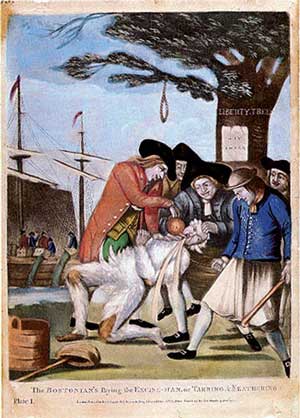
ABOVE: “The Bostonians Paying the Excise Man.”
(1774 print, attributed to P. Dawe.)
Chastisement in the pursuit of justice remains one of the most hotly contested and debated issues of the day. From capital punishment to humiliation practices, consequences suffered by those who commit crimes are intended to set an example. The debate lies in how far one can go in the pursuit of righteousness. Many citizens today believe that more criminals deserve to be rehabilitated rather than incarcerated, while others rally for harsher and lengthier sentences. Recent accusations of torture and inhumane interrogation techniques have reopened the public’s examination of how prisoners should, and should not, be treated.
In the early days of primitive America, vigilante justice, or “mob rules,” commanded the streets as angry citizens took it upon themselves to act as judge, jury, and in some cases, executioner. Many of the methods used at this time were exceptionally painful and permanently scarring. Some of the harshest punishments can be traced back to the crown, hundreds of years before any Englishman ever set foot in the New World. Perhaps the most disturbing form of retribution to be dispensed in the colonial era was the act of tarring and feathering. This was an unsanctioned penalty in which an individual would have boiling hot tar poured over or brushed onto them, then they would be either covered in - or rolled in - feathers. Sometimes the person would be stripped naked and carried around town upon a rail. The goal was to humiliate them to the point that they would vacate the town, never to return.
This painful procedure was originally endorsed by English law in the late 1100’s. The earliest mention of “official” tar and feathering occurred in the orders of King Richard I of England, who issued them to his navy before sailing for the Holy Land in 1191. It is believed that this primitive ordinance aimed at criminal crusaders inspired the use of the technique in the colonies during the turbulent days leading up to the revolution. What follows is a transcript of what is believed to be the only royal declaration in existence that specifically instructs the use of tar and feathering:
Laws of Richard I (Coeur de Lion) Concerning Crusaders Who Were to Go by Sea. 1189 A.D. ("Roger of Hoveden," III p. 36 [Rolls Series].)
Richard by the grace of God king of England, and duke of Normandy and Aquitaine, and count of Anjou, to all his subjects who are about to go by sea to Jerusalem, greeting. know that we, by the common counsel of upright men, have made the laws here given. Whoever slays a man on ship. board shall be bound to the dead man and thrown into the sea. But if he shall slay him on land, he shall be bound to the dead man and buried in the earth. If any one, moreover, shall be convicted through lawful witnesses of having drawn a knife to strike another, or of having struck him so as to draw blood, he shall lose his hand. But if he shall strike him with his fist without drawing blood, he shall be dipped three times in the sea. But if any one shall taunt or insult a comrade or charge him with hatred of God: as many times as he shall have insulted him, so many ounces of silver shall he pay. A robber, moreover, convicted of theft, shall be shorn like a hired fighter, and boiling tar shall be poured over his head, and feathers from a cushion shall be shaken out over his head,-so that he may be publicly known; and at the first land where the ships put in he shall be cast on shore. Under my own witness at Chinon.
Source: Henderson, Ernest F.
Select Historical Documents of the Middle Ages
London: George Bell and Sons, 1896
Updated: Thursday, 25 March 2010 10:15 AM EDT
Permalink | Share This Post





